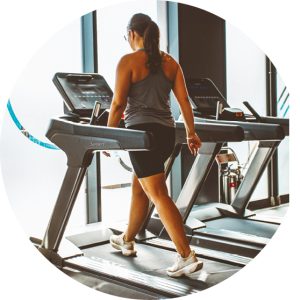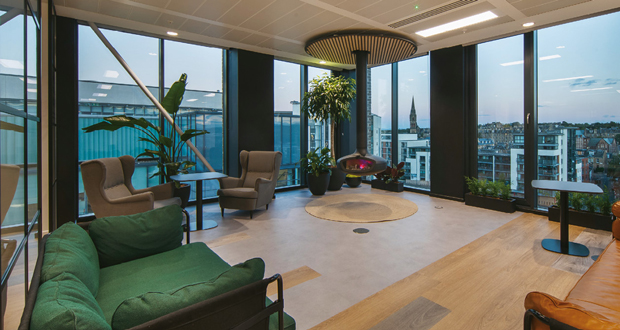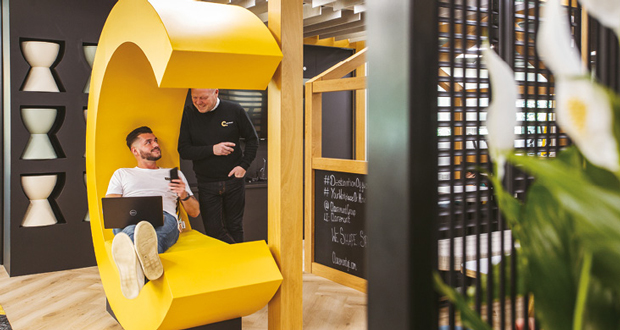Wellbeing now plays an essential role in the design, management and creation of a balanced workplace, says Sarah Syson, Design Manager at Claremont
With many organisations striving to find a new sense of normality in an increasingly hybrid world, employers need to balance the flexibility they offer to individuals with the needs of the team so that their people, productivity and profitability can thrive.
Tied up within this is the need to create a balanced workplace – one where wellbeing is a key influence in its design, management and use. For facilities and estates management professionals, it presents a unique opportunity to help deliver important change and create environments that proactively support and nurture the health and wellness of those that use them. In fact, it is facilities professionals that have the power to shape the next generation of wellness-led workplaces.
HEALTH IS WEALTH
Without positive health and wellbeing, people will not thrive. It’s a realisation that has been climbing the corporate agenda for the last decade, but especially since the pandemic. Mental health is perhaps the most topical and widely recognised element, but true wellbeing also considers people’s intellectual, physical, emotional, social and financial needs.
Business leaders now understand that their approach to wellbeing impacts recruitment, retention, reputation, productivity and profitability and crucially, the employee experience.
The benefits of this holistic approach to wellness are compelling. A study carried out by Deloitte found that poor mental health costs UK employers up to £45 billion each year, which is a rise of 16 per cent since 2016 – an extra £6 billion a year.  The research also reported that employers who have invested in their people’s wellbeing are getting incredible returns. On average, for every £1 spent on supporting their people’s wellness and mental health, employers get £5 back on their investment in reduced absenteeism, staff turnover, productivity, creativity and so much more.
The research also reported that employers who have invested in their people’s wellbeing are getting incredible returns. On average, for every £1 spent on supporting their people’s wellness and mental health, employers get £5 back on their investment in reduced absenteeism, staff turnover, productivity, creativity and so much more.
EMPLOYEE EXPERIENCE
Set against this backdrop, it’s clear that workplace design has to support and deliver wellness. This is tied up in the employee experience – the idea that employers must curate positive and desirable experiences – if they are to keep their people happy, healthy, motivated and connected to the company’s values and mission. In the context of the workplace and its design, this means acknowledging the shifting behaviours of hybrid workers, recognising their holistic needs and offering the personalised experiences and facilities they can’t access elsewhere.
To do this, we have to acknowledge what working from home or remotely could look like. Employees may be buoyed without a daily commute, but they could be working in a less than ideal environment (perhaps on a fixed height kitchen table, without an ergonomic chair or from a dark box room). They might struggle to separate work and home and over time, this could make them feel isolated. We also know that many remote workers typically complete quiet, lone and concentrated tasks at home.
Consequently, the workplace has to pick up the slack and provide what’s missing. It has to offer the best facilities and work settings, it must provide choice and variety, it has to promote social encounters and enable face-to face collaboration. Where once company perks might have been free parking or a season rail ticket (no longer so compelling in a hybrid world), it is the workplace and the experiences it offers that have the power to become the new perks.
This opportunity for change is a far cry from the years of ‘wellbeing’ being belittled as nothing more than subsidised gym membership for staff, free fresh fruit or a quiet room that doubled up as a store cupboard, rather than being about meaningful wellness in all its guises.
Now, there is an opportunity to consider how people behave, the amenities they want and how space can respond. It’s a process that starts with considering nine key areas:
MORE THAN A WORKPLACE
The workplace is more than just a place of work. It’s also a place for socialisation, learning, connection, relaxation and collaboration, which means it must accommodate multiple uses. Touchdown spaces, collaboration zones, cafes, games rooms, outdoor gardens, spaces for quiet reflection and areas for company-wide meetings or social gatherings, all have a part of play. Proactively building these into space plans and thinking about how they are collocated (so a noisy collaboration space isn’t next to a quiet space for example) can ensure a balanced workplace.
THE AGE OF CHOICE
Choice is inherently linked with wellbeing. Giving employees the autonomy to choose the right workspace for the task, or to meet their specific needs, be that in relation to their level of physical ability, neurodiverse condition or simply how they’re feeling that day, are all part of the picture. So while choice definitely requires variety, it also requires a culture of empowerment where employees feel trusted and able to choose for themselves. Open plan workspaces, bookable zones and a move away from owned desks in favour of shared spaces, can help people to take control and build personal wellness into their day.






